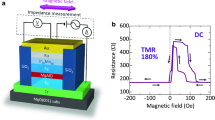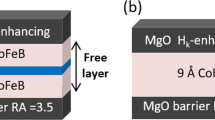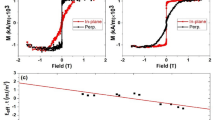Abstract
Magnetic tunnel junctions (MTJs) with ferromagnetic electrodes possessing a perpendicular magnetic easy axis are of great interest as they have a potential for realizing next-generation high-density non-volatile memory and logic chips with high thermal stability and low critical current for current-induced magnetization switching1,2,3. To attain perpendicular anisotropy, a number of material systems have been explored as electrodes, which include rare-earth/transition-metal alloys4,5, L10-ordered (Co, Fe)–Pt alloys3,6,7 and Co/(Pd, Pt) multilayers1,8,9,10. However, none of them so far satisfy high thermal stability at reduced dimension, low-current current-induced magnetization switching and high tunnel magnetoresistance ratio all at the same time. Here, we use interfacial perpendicular anisotropy between the ferromagnetic electrodes and the tunnel barrier of the MTJ by employing the material combination of CoFeB–MgO, a system widely adopted to produce a giant tunnel magnetoresistance ratio in MTJs with in-plane anisotropy11,12,13. This approach requires no material other than those used in conventional in-plane-anisotropy MTJs. The perpendicular MTJs consisting of Ta/CoFeB/MgO/CoFeB/Ta show a high tunnel magnetoresistance ratio, over 120%, high thermal stability at dimension as low as 40 nm diameter and a low switching current of 49 μA.
This is a preview of subscription content, access via your institution
Access options
Subscribe to this journal
Receive 12 print issues and online access
$259.00 per year
only $21.58 per issue
Buy this article
- Purchase on Springer Link
- Instant access to full article PDF
Prices may be subject to local taxes which are calculated during checkout





Similar content being viewed by others
References
Mangin, S. et al. Current-induced magnetization reversal in nanopillars with perpendicular anisotropy. Nature Mater. 5, 210–215 (2006).
Meng, H. & Wang, J. P. Spin transfer in nanomagnetic devices with perpendicular anisotropy. Appl. Phys. Lett. 88, 172506 (2006).
Kishi, T. et al. Lower-current and fast switching of a perpendicular TMR for high speed and high density spin-transfer-torque MRAM. IEDM Tech. Dig. 309–312 (2008).
Nishimura, N. et al. Magnetic tunnel junction device with perpendicular magnetization films for high-density magnetic random access memory. J. Appl. Phys. 91, 5246–5249 (2002).
Ohmori, H., Hatori, T. & Nakagawa, S. Perpendicular magnetic tunnel junction with tunnelling magnetoresistance ratio of 64% using MgO(100) barrier layer prepared at room temperature. J. Appl. Phys. 103, 07A911 (2008).
Yoshikawa, M. et al. Tunnel magnetoresistance over 100% in MgO-based magnetic tunnel junction films with perpendicular magnetic L10-FePt electrodes. IEEE Trans. Magn. 44, 2573–2576 (2008).
Kim, G., Sakuraba, Y., Oogane, M., Ando, Y. & Miyazaki, T. Tunnelling magnetoresistance of magnetic tunnel junctions using perpendicular magnetization L10-CoPt electrodes. Appl. Phys. Lett. 92, 172502 (2008).
Carvello, B. et al. Sizable room-temperature magnetoresistance in cobalt based magnetic tunnel junctions with out-of-plane anisotropy. Appl. Phys. Lett. 92, 102508 (2008).
Park, J-H. et al. Co/Pt multilayer based magnetic tunnel junctions using perpendicular magnetic anisotropy. J. Appl. Phys. 103, 07A917 (2008).
Mizunuma, K. et al. MgO barrier-perpendicular magnetic tunnel junctions with CoFe/Pd multilayers and ferromagnetic insertion layers. Appl. Phys. Lett. 95, 232516 (2009).
Parkin, S. S. P. et al. Giant tunnel magnetoresistance at room temperature with MgO(100) tunnel barrier. Nature Mater. 3, 862–867 (2004).
Yuasa, S., Nagahama, T., Fukushima, A., Suzuki, Y. & Ando, K. Giant room-temperature magnetoresistance Fe/MgO/Fe magnetic tunnel junctions. Nature Mater. 3, 868–871 (2004).
Ikeda, S. et al. Tunnel magnetoresistance of 604% at 300 K by suppression of Ta diffusion in CoFeB/MgO/CoFeB/ pseudo-spin-valves annealed at high temperature. Appl. Phys. Lett. 93, 082508 (2008).
Ikeda, S. et al. Magnetic tunnel junctions for spintronic memories and beyond. IEEE Trans. Electron Devices 54, 991–1002 (2007).
Ovanov, O. A., Solina, L. V., Demshina, V. A. & Magat, L. M. Determination of the anisotropy constant and saturation magnetization and magnetic properties of powders of an iron-platinum alloy. Phys. Met. Metallogr. 35, 81–85 (1973).
Slonczewski, J. Current-driven excitation of magnetic multilayers. J. Magn. Magn. Mater. 159, L1–L7 (1996).
Berger, L. Emission of spin waves by a magnetic multilayer traversed by a current. Phys. Rev. B 54, 9353–9358 (1996).
Sakuma, A. First principle calculation of the magnetocrystalline anisotropy energy of FePt and CoPt ordered alloys. J. Phys. Soc. Jpn 63, 3053–3058 (1994).
Barman, A. et al. Ultrafast magnetization dynamics in high perpendicular anisotropy [Co/Pt]n multilayers. J. Appl. Phys. 101, 09D102 (2007).
Mizukami, S., Ando, Y. & Miyazaki, T. The study on ferromagnetic resonance linewidth for NM/80NiFe/NM (NM=Cu, Ta, Pd and Pt) films. Jpn. J. Appl. Phys. 40, 580–585 (2001).
Oogane, M. et al. Magnetic damping in ferromagnetic thin films. Jpn. J. Appl. Phys. 45, 3889–3891 (2006).
Yakata, S. et al. Influence of perpendicular magnetic anisotropy on spin-transfer switching current in CoFeB/MgO/CoFeB magnetic tunnel junctions. J. Appl. Phys. 105, 07D131 (2009).
Hosomi, M. et al. Progress in spin transfer torque MRAM (SpRAM) development. Magnetics Japan 2, 606–614 (2007) [in Japanese].
Yamane, K. et al. Memory device and memory. US patent 2009/0285017 A1 (2009).
Draaisma, H. H. G., Jonge, W. J. M. & Broeder, F. J. A. Magnetic interface anisotropy in Pd/Co and Pd/Fe multilayer. J. Magn. Magn. Mater. 66, 351–355 (1987).
Endo, M., Kanai, S., Ikeda, S., Matsukura, F. & Ohno, H. Electric field effects on thickness dependent magnetic anisotropy of sputtered MgO/Co40Fe40B20/Ta structures. Appl. Phys. Lett. 96, 212503 (2010).
Shimabukuro, R., Nakamura, K., Akiyama, T. & Ito, T. Electric field effects on magnetocrystalline anisotropy in ferromagnetic Fe monolayers. Physica E 42, 1014–1017 (2010).
Monso, S. et al. Crossover from in-plane to perpendicular anisotropy in Pt/CoFe/AlOx sandwiches as a function of Al oxidation: A very accurate control of the oxidation of tunnel barrier. Appl. Phys. Lett. 80, 4157–4159 (2002).
Manchon, A. et al. Analysis of oxygen induced anisotropy crossover in Pt/Co/MOx trilayers. J. Appl. Phys. 104, 043914 (2008).
Nistor, L. E., Rodmancq, R., Auffret, A. & Dieny, B. Pt/Co/oxide electrodes for perpendicular magnetic tunnel junctions. Appl. Phys. Lett. 94, 012512 (2009).
Karthik, S.V. et al. Transmission electron microscopy investigation of CoFeB/MgO/CoFeB pseudospin valves annealed at different temperatures. J. Appl. Phys. 106, 023920 (2009).
Koch, R. H., Katine, J. A. & Sun, J. Z. Time-resolved reversal of spin-transfer switching in a nanomagnet. Phys. Rev. Lett. 92, 088302 (2004).
Acknowledgements
We thank I. Morita, T. Hirata, A. Fukunaga and S. Koike for their technical support as well as M. Shirai for discussion. The work was supported in part by the ‘High-performance low-power consumption spin devices and storage systems’ program under Research and Development for Next-Generation Information Technology of MEXT, by the Japan Society for the Promotion of Science (JSPS) through its ‘Funding program for world-leading innovative R & D on science and technology (FIRST program)’ and the GCOE program at Tohoku University.
Author information
Authors and Affiliations
Contributions
S.I. and H.O. planned and supervised the study. S.I., F.M. and H.O. wrote the manuscript. K. Mizunuma, K. Miura, H.Y. and H.D.G. prepared samples and fabricated devices. K. Mizunuma, M.E. and S.K. investigated magnetic characteristics. H.Y. measured FMR spectra. K. Miura and H.Y. investigated the electrical properties of MTJ devices. All authors analysed the data, discussed the result and commented on the manuscript.
Corresponding authors
Ethics declarations
Competing interests
The authors declare no competing financial interests.
Rights and permissions
About this article
Cite this article
Ikeda, S., Miura, K., Yamamoto, H. et al. A perpendicular-anisotropy CoFeB–MgO magnetic tunnel junction. Nature Mater 9, 721–724 (2010). https://doi.org/10.1038/nmat2804
Received:
Accepted:
Published:
Issue Date:
DOI: https://doi.org/10.1038/nmat2804
This article is cited by
-
Single-nanometer CoFeB/MgO magnetic tunnel junctions with high-retention and high-speed capabilities
npj Spintronics (2024)
-
Bifurcation to complex dynamics in largely modulated voltage-controlled parametric oscillator
Scientific Reports (2024)
-
The central role of tilted anisotropy for field-free spin–orbit torque switching of perpendicular magnetization
NPG Asia Materials (2024)
-
Spintronic virtual neural network by a voltage controlled ferromagnet for associative memory
Scientific Reports (2024)
-
Structural and Magnetic Studies on Mn2TiSi Heusler Alloy for Spintronics Applications
Journal of Superconductivity and Novel Magnetism (2024)



